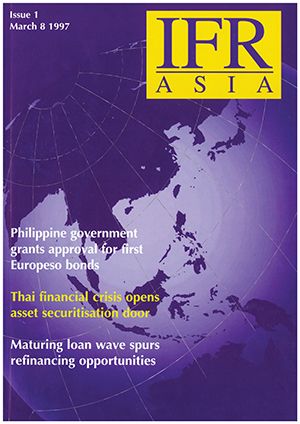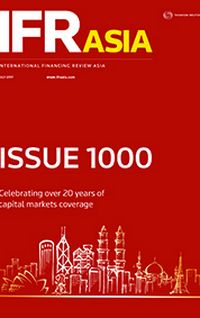IFR Asia’s first issue came off the presses on March 8 1997, and painted a mixed picture of pre-crisis Asia. While Indonesia’s capital markets were clearly roaring, things were already looking rocky in Thailand.
Top story was a colourful feature on Indonesia, detailing “flagrant abuses” of the emerging domestic market for MTNs.
“We once bought US$80m of a US$100m dollar issue from an MTN programme, but then found out that someone else had bought US$70m of the same programme,” a US banker in Singapore was quoted as saying. Who cared about trivial items such as disclosure when prices were going up?
In another report on the gold rush in Indonesia, an equity salesman working on a US$200m–$250m IPO for consumer finance group Putra Surya Multidana suggested “a grandmother with an answering machine could sell the deal”. (Presumably she would have needed a few cassette tapes for the device, too.)
Well-known issuers in the first edition included the infamous Asia Pulp & Paper, whose Indah Kiat unit had just drawn a 20% oversubscription for a US$400m syndicated loan led by BA Asia and Fuji Bank. Noble Group was just about to close its US$45m Singapore IPO, via UOB, Indosuez WI Carr and Nomura.
The Philippines was also in on the action, with Citigroup winning the mandate for the first international europeso bond. The US bank would go on to raise about US$100m for the International Finance Corp with a five-year note at 10.25%.
India’s Reliance Industries had recently sold Asia’s first century bond, convincing investors to take 100-year paper at a yield of 10.25% – a deal investors would no doubt jump at today.
Also in India, VSNL was heading for a successful GDR listing via Dresdner Kleinwort Benson, Jardine Fleming and Salomon Brothers.
Over in Hong Kong, Morgan Stanley was marketing an IPO for a Chinese client, Beijing Datang Power, Merrill Lynch had just launched a popular 10-year US dollar bond for Wharf (Holdings), and Hongkong Electric had mandated HSBC for a seven-year loan at 35bp over Hibor. Some things never change.
CRACKS EMERGING
The Thai market, meanwhile, was already showing signs of stress. In the global markets, Lehman Brothers and Salomon Brothers had picked up a mandate from the Kingdom of Thailand, but it was the local finance companies that were running into trouble.
The first IFR Asia issue reported on the emergency merger of Finance One, Thailand’s largest finance company, and Thai Danu Bank, which was credited with averting a wholesale meltdown of the financial system. IFR Asia wasn’t entirely convinced, calling on Thailand’s overextended finance companies to “take a long hard look at long-term funding” in its first editorial. Finance One, for instance, had been discussing a US$500m securitisation before it ran into trouble.
Hindsight always brings clarity, but it is notable that the Thai syndicated loans section was dominated by Japanese lenders, while the Thai bond markets recorded zero issuance “amid growing worries over the Thai financial system and continued credit concerns towards Thai corporates”. Quite so.
Other signs of stress were also hidden in plain sight.
Peregrine, the homegrown Asian investment bank, was losing staff. In an article detailing three departures, IFR Asia wrote “the firm is noted for its aggressive style of management” – prescient, perhaps, given the firm’s demise less than a year later.
Many other names from the first issue are no longer with us. All Asia Capital & Trust, a privately owned Philippines lender, featured regularly as an arranger, as did Rashid Hussain in Malaysia, the precursor to RHB Bank. Sakura Finance, which would be merged into Sumitomo Mitsui Banking Corp in 2001, was also prominent in South-East Asia.
At a hefty 68 pages, IFR Asia’s first issue offered little sign of the trouble to come. Early business was also brisk, with several pages sold to both local and international advertisers.
Some of those would also succumb to the crisis. Private Development Finance Company of Indonesia, or PDFCI, which took the first double page spread in issue one, survived the first wave of failures that ripped through Indonesia’s banking system, but was taken over by the government’s restructuring agency in April 1998 and merged with Danamon the following year.
Still, IFR Asia’s first issue was hardly the top of the market. For that, look no further than Issue 2, which led with another cracking deal: “Banque Nationale de Paris has capitalised on growing interest in North Korean debt by structuring a securitisation of defaulted bank loans…”
For other articles in IFR Asia’s 20th anniversary special report please click here. To read the digital version of this report please click here .
To purchase printed copies or a PDF of this report, please email gloria.balbastro@thomsonreuters.com .



